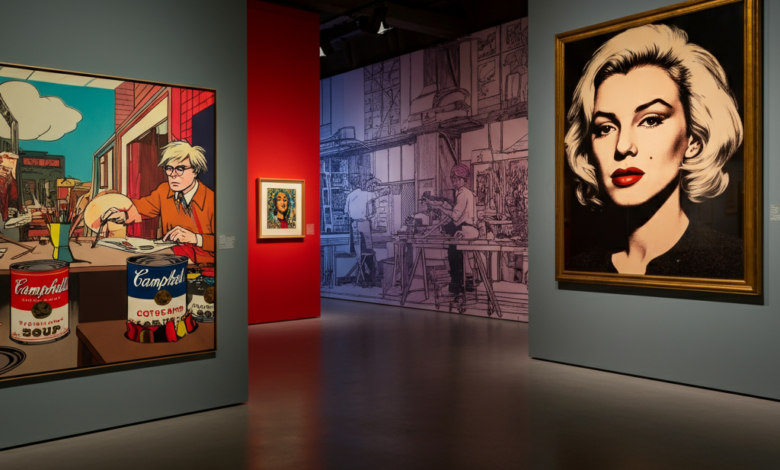Andy Warhol and the Vibrant World of Pop Art

Who Was Andy Warhol? A Snapshot of His Life and Legacy
Andy Warhol, born Andrew Warhola in 1928 in Pittsburgh, Pennsylvania, is undeniably one of the most celebrated and controversial figures in 20th-century art. Known for his deadpan demeanor and unmistakable style, Warhol redefined what it meant to be an artist. From his early career as a commercial illustrator to his reign as the “king of Pop Art,” Warhol’s meteoric rise to fame mirrored the cultural evolution of post-war America andywarhella.
Warhol once famously quipped, “Art is what you can get away with.” Whether you see this as cheeky irreverence or profound commentary, it perfectly encapsulates his ethos as an artist. Equal parts cultural critic and fervent observer, Warhol revolutionized the art world by blurring boundaries between high art and popular culture.
The Pop Art Movement and Warhol’s Revolutionary Role
Before Warhol became a household name, the post-World War II art world was dominated by Abstract Expressionism, characterized by intense emotions and dramatic strokes. Pop Art emerged in the 1950s as a direct response to this, celebrating the banal, the repetitive, and the mass-produced andywarhella.
Warhol was not the first Pop Artist, but he became its emblem—a living, breathing figurehead. Inspired by everyday objects and media imagery, Warhol elevated Campbell’s soup cans and Coca-Cola bottles into revered works of art. His interpretation of celebrity culture, ubiquitous branding, and capitalism tapped into the collective psyche of an America obsessed with consumption and fame.
Through Warhol’s lens, the items we take for granted became symbols of a society in transition. By replicating these images in striking colors and repetition, Warhol challenged the idea of what art could be.
Andy Warhol’s Iconic Works
Warhol created a staggering portfolio of provocative and thought-provoking pieces. Few of his works are more legendary than these:
1. Campbell’s Soup Cans (1962): The series that propelled Warhol into the limelight. Each canvas featured a simple depiction of a Campbell’s soup can, representing every variety sold at the time. Through its obsessive reproduction, Warhol questioned notions of originality in art and highlighted society’s fixation with consumer goods.
2. Marilyn Diptych (1962): Warhol’s multi-paneled homage to Marilyn Monroe interrogates the commodification of celebrity and the tragedy of fame. By repeating Marilyn’s image, he mimicked the media’s over-saturation of her likeness, while leaving some panels purposefully faded—a poignant reminder of her untimely death.
3. Silver Car Crash (Double Disaster) (1963): From Warhol’s “Death and Disaster” series, this stark piece juxtaposed glamour with horror, using repetition to desensitize viewers to trauma, revealing the media’s role in diminishing the weight of individual suffering.
Warhol’s ability to take something recognizable and transform it into a multifaceted cultural commentary was nothing short of genius. He forced audiences to reexamine their values and the world around them.
The Factory and Warhol’s Influence
Much of Warhol’s work wasn’t created in isolation, but in his renowned studio known as The Factory. Located in New York City, The Factory was more than just a workspace; it was a cultural epicenter. Artists, writers, musicians, and Hollywood celebrities flocked to its metallic, foil-covered walls. Figures like Lou Reed, Bob Dylan, and Edie Sedgwick were frequent collaborators and featured muses.
At The Factory, Warhol radically changed art production by leveraging assistant-led manufacturing practices. This assembly-line approach blurred the lines between creator and product, mirroring the industrial processes that defined consumer culture andywarhella.
The Factory was also an incubator for Warhol’s multimedia endeavors. From his experimental films like “Sleep” (1963) and “Empire” (1964) to producing albums for The Velvet Underground, Warhol expanded art into music and cinema, further proving his ability to distill pop culture into fine art.
Warhol’s Legacy in Contemporary Art and Culture
It would be impossible to discuss modern art without mentioning Andy Warhol. His impact resonates far beyond gallery walls and auction houses, extending into contemporary advertising, fashion, and social media. Today, his works continue to inspire debates about authenticity, celebrity obsession, and the commodification of daily life.
Artists like Jeff Koons, Damien Hirst, and Takashi Murakami have all drawn inspiration from Warhol’s ethos, embedding his spirit firmly into the DNA of contemporary art. Digital platforms like Instagram seem almost tailor-made for Warhol’s aesthetic of repetition and self-curated fame. Would Warhol have been an influencer in today’s world? Almost certainly.
Even academically, discussions around Warhol remain alive and well. His legacy serves as a reminder that art isn’t about strict definitions but about pushing boundaries and making audiences see things differently andywarhella.
How Andy Warhol Redefined Art Forever
Andy Warhol’s life and work weren’t just about soup cans, celebrity silkscreens, or eccentric soundbites; they were an entire philosophy. Warhol taught us that art is everywhere—for those willing to look. From a commonplace product to a Hollywood icon, his eye for insight transformed the ordinary into the extraordinary andywarhella.
Whether you resonate with his vision or question his methods, Warhol holds a mirror up to society, asking questions about consumerism, fame, and identity that are as relevant today as they were in his time. And in doing so, he ensures his place as one of history’s most important artists—an icon of both his era and ours.


